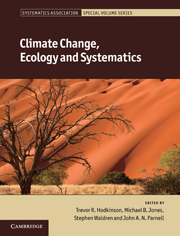Book contents
- Frontmatter
- Contents
- List of contributors
- Preface
- Section 1 Introduction
- Section 2 Adaptation, speciation and extinction
- 4 Global climate and extinction: evidence from the fossil record
- 5 Long-term fluctuations in atmospheric CO2 concentration influence plant speciation rates
- 6 Wood anatomy and climate change
- 7 Savanna biome evolution, climate change and the ecological expansion of C4 grasses
- 8 Climate warming results in phenotypic and evolutionary changes in spring events: a mini-review
- 9 Terrestrial green algae: systematics, biogeography and expected responses to climate change
- Section 3 Biogeography, migration and ecological niche modelling
- Section 4 Conservation
- Index
- Systematics Association Publications
- Plate section
- References
9 - Terrestrial green algae: systematics, biogeography and expected responses to climate change
from Section 2 - Adaptation, speciation and extinction
Published online by Cambridge University Press: 16 May 2011
- Frontmatter
- Contents
- List of contributors
- Preface
- Section 1 Introduction
- Section 2 Adaptation, speciation and extinction
- 4 Global climate and extinction: evidence from the fossil record
- 5 Long-term fluctuations in atmospheric CO2 concentration influence plant speciation rates
- 6 Wood anatomy and climate change
- 7 Savanna biome evolution, climate change and the ecological expansion of C4 grasses
- 8 Climate warming results in phenotypic and evolutionary changes in spring events: a mini-review
- 9 Terrestrial green algae: systematics, biogeography and expected responses to climate change
- Section 3 Biogeography, migration and ecological niche modelling
- Section 4 Conservation
- Index
- Systematics Association Publications
- Plate section
- References
Summary
Abstract
Terrestrial green microalgae are among the most widespread and evolutionarily diverse organisms inhabiting terrestrial environments. In the last 30 years, ultrastructural and molecular data have led to important insights into the evolution of these organisms. It has become clear that terrestrial green algae are a highly polyphyletic group originating from the colonisation of terrestrial environments by many separate lineages of aquatic algae, both freshwater and marine. Such diversity implies great differences in physiological and biochemical attributes, with the consequence that different taxa are expected to exhibit different responses to climatic changes. Elevated carbon dioxide (CO2), variations in rainfall and humidity and increased photosynthetically active radiation (PAR) and ultraviolet (UV) radiation are the aspects of global change that will most likely affect terrestrial green algae. The published information on impacts of global change is largely based on short-term studies, which have examined the immediate response of algae to experimental manipulation of climatic parameters. However, recent experimental long-term studies have shown that green microalgae evolve in response to climatic change, and the physiological responses of algal strains in present-day conditions might not reflect the responses of the same strains in future climate scenarios.
Introduction
As generally defined, the term algae includes all photosynthetic eukaryotes with the exception of land plants (Brodie and Zuccarello, 2007; Delwiche, 2007). Members of this highly diverse, non-monophyletic set of organisms occur in any habitat in which sufficient photon irradiance for photosynthesis is available, and they contribute to global primary production to an extent which may reach 50% (Beardall and Raven, 2004).
- Type
- Chapter
- Information
- Climate Change, Ecology and Systematics , pp. 201 - 228Publisher: Cambridge University PressPrint publication year: 2011
References
- 21
- Cited by

